
Included as part of the latest release from the Military Service (1916-1923) Pensions Collection (MSPC) is a relisting of the IRA nominal roll or membership series (RO). Where previously there were divisional or brigade level descriptions for the series now there is a description for each individual file in the series. This relisting was undertaken to make this very important part of the collection more accessible and to highlight the other types of documentation that can often be found on these files in conjunction with the membership listings. This article will look briefly at the background to the RO series and will highlight some of the additional material, apart from the membership listings themselves, that can be found on the files.
To access the IRA nominal roll series click here. To view all IRA nominal roll files click here. To search for an individual RO file click here. To read a previous blog article with further information on the nominal roll (RO) series click here.
The nominal roll series was created to assist the work of the Referee and Advisory Committee in verifying service claims lodged under the Military Service Pensions Act, 1934. As the IRA was an underground and not a regular army, proper surviving records of membership were of necessity generally few and far between. At the direction of the Office of the Referee, committees, reflecting the IRA structure of the War of Independence and Civil War periods, were established. These committees, comprised where possible, of the most senior IRA officers available for each brigade area, were to gather and submit organisational records for their respective areas and to support the work of the Referee and Advisory Committee in judging accurately, fairly and in a timely fashion, the claims made by the many thousand military service pension applicants.
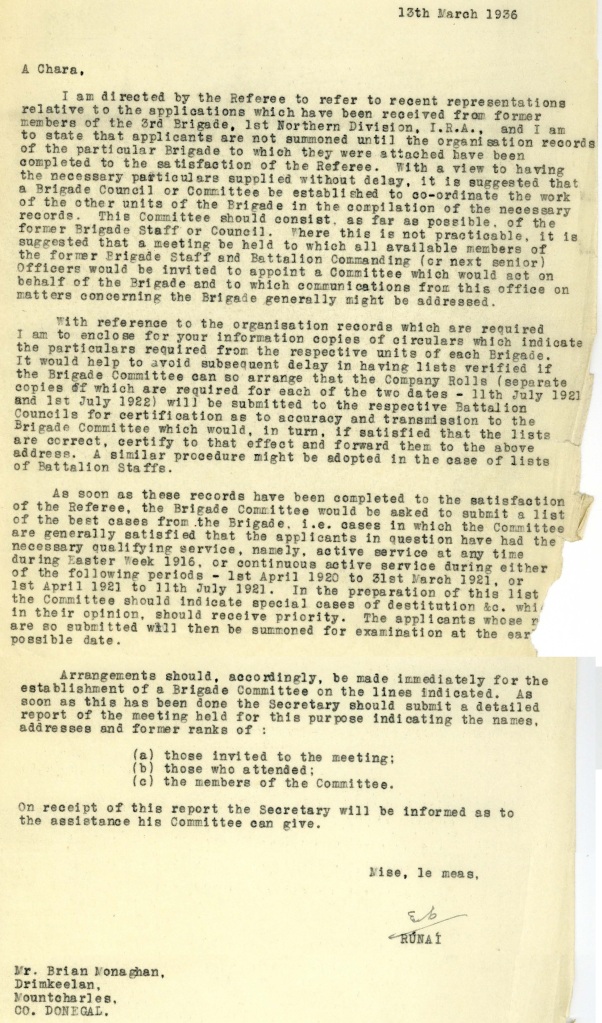
In the case of the IRA, details of the membership personnel at divisional, brigade, battalion and company levels were sought, as was the membership of flying columns/active service units. To meet the requirements of the military service pension legislation, these details were to relate specifically to what were known as the first and second critical dates – 11 July 1921 and 1 July 1922 respectively.
The provision of membership figures for IRA units was also important, as, under the legislation, the pension grade, and thus the amount of pension actually paid to a successful applicant, could be significantly affected. For example, the commanding officer of a battalion with a strength of over 300 on either critical date, would receive £5 (five pounds sterling) more per year of service awarded, than the commanding officer of a battalion with less than 300 members.
The resulting RO series is comprised of around 600 files, referenced RO1 to 611, with almost 50,000 individual documents scanned. It includes membership details for 16 Divisions of the IRA, constituting a total of 87 Brigades, including units in England and the Scottish Brigade (technically termed a Division as a second Scottish Brigade was also in existence by 1 July 1922. In addition, two files dealing with the appointment of the Chief of Staff, General staff officers, the commanders of the Directorates and the exercise of command by GHQ from 1919 are included. (RO601 and 601A).
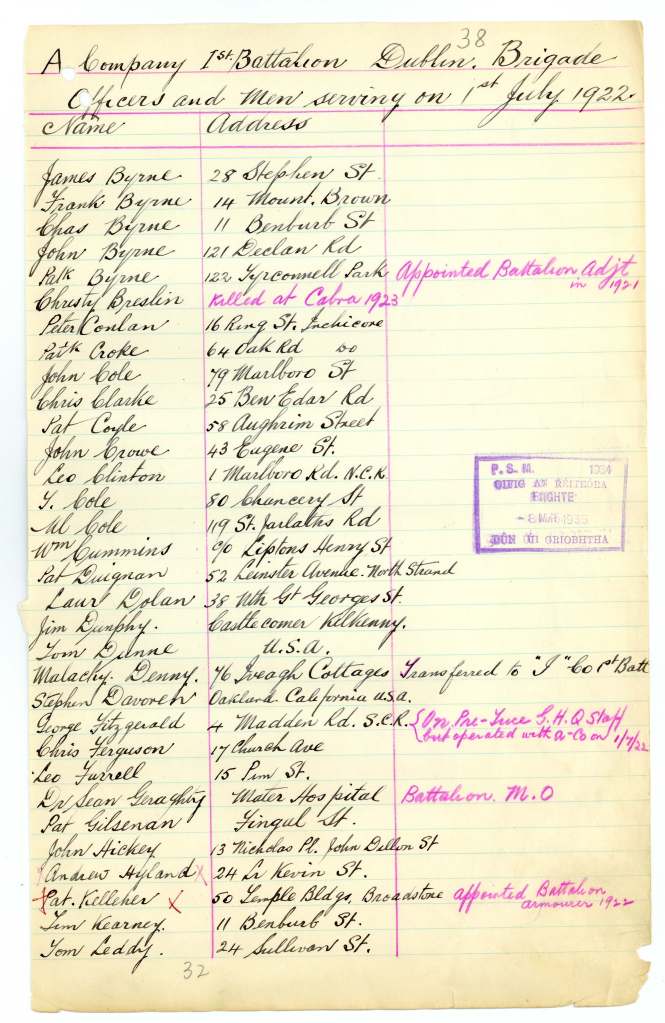
Unsurprisingly the largest amount of material and most important aspect of the RO series is of course the membership listings themselves. Through these listings we can see both how the IRA was structured and who actually made up the membership of that organisation. The RO series is a crucial addition to the pension files themselves as for a variety of reasons not all of those listed have files relating to them elsewhere in the MSPC. Those who died or were killed during the conflicts, or died later as a result of their service, required a surviving relative in a position to make a claim in their name, either as a dependent, or for a posthumous medal, for a file to be created. Similarly not all veterans were inclined or able to make a claim on their own behalf. As a result, a mention in these listings may now be the only proof available that a particular individual ever took part in the events of that time.
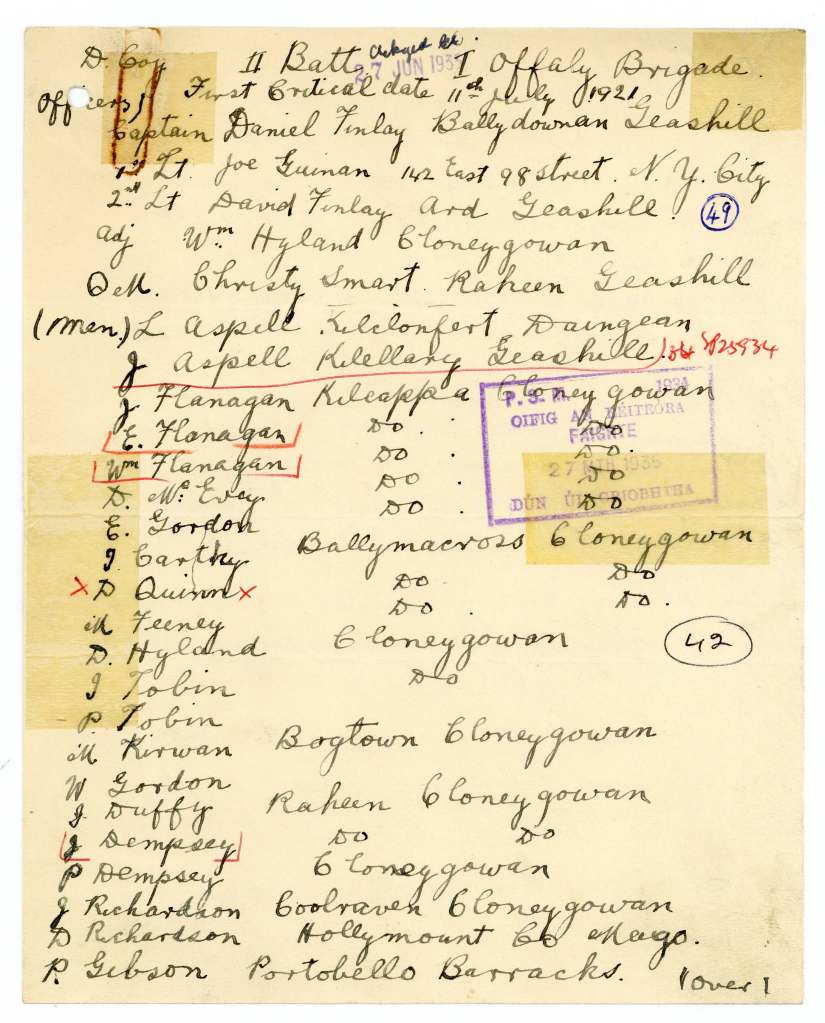
Although of crucial importance, the membership listings are not the only interesting documents in the series. Featured, most notably in the files relating to divisional and brigade headquarters, is material relating to the establishment and workings of the committees of former IRA officers set up to oversee and carry out the compilation and submission of these listings to the Referee and Advisory Committee. These committees, as already mentioned, were generally formed at brigade level – and were referred to as Brigade Committees – although on occasion committees were also formed to represent divisional and battalion level in some parts of the country.
These committees were generally successful in their work, as the existence and content of these files indicate. However they were not without their difficulties. Most obviously there was the difficulty of establishing, largely from memory and at a distance of over a decade, exactly who was or was not a member of an underground revolutionary movement during a period of intense violence and turmoil. There was also the fact that the major reorganisation undergone by the IRA with the introduction of divisions – a process begun in early 1921 during the War of Independence but not completed until 1922 during the Truce period – meant that some units and members belonging to entirely different brigades on 11 July 1921 and 1 July 1922
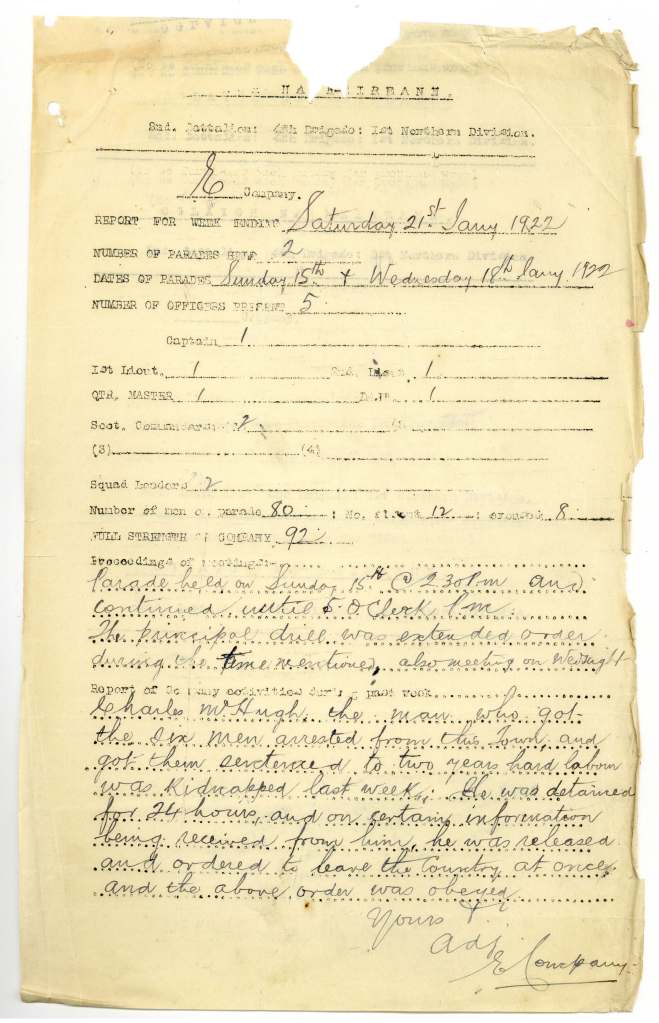
Then there was also the misunderstanding, by some former IRA officers, of what the Referee and his officials were looking for. For example some listings can be vague or contain no mention at all of the date(s) they refer to, or can claim to refer to both critical dates. Some former officers were also unsure whether to include all those who belonged to the companies/units they commanded or just the most “active” members. There was also occasional confusion on whether or not to include those who had been recruited during the Truce period when giving membership details for 1 July 1922.
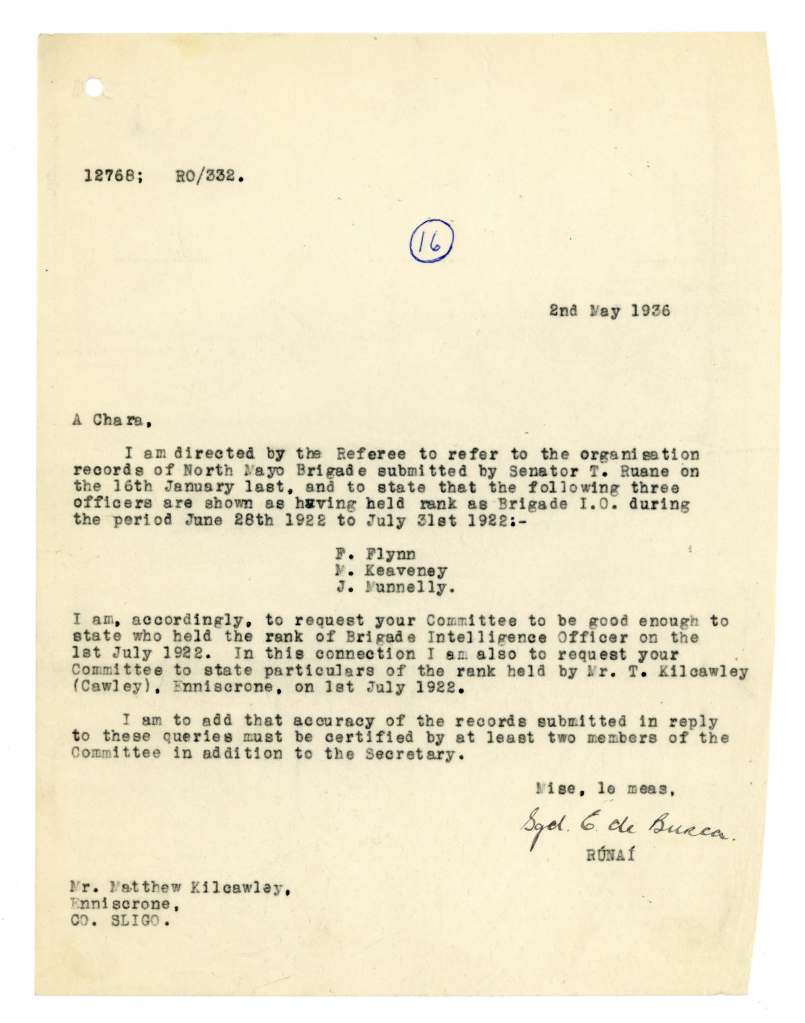
As a result more than one membership listing or figure can often be found in the files for one or both critical dates for very many of the IRA companies and units concerned. Listings for companies for the same date can also occasionally appear in more than one file. Officials of the Office of the Referee would query and ask for an explanation for discrepancies that arose. In general it would appear from the material on the files that explanations for such discrepancies, which generally related to the factors mentioned above, were accepted. It would also appear that the honesty of those compiling and submitting the material, and the integrity of the records they were sending to the Referee and his officials was generally accepted. However, as we shall see later in the article, there may have been exceptions.
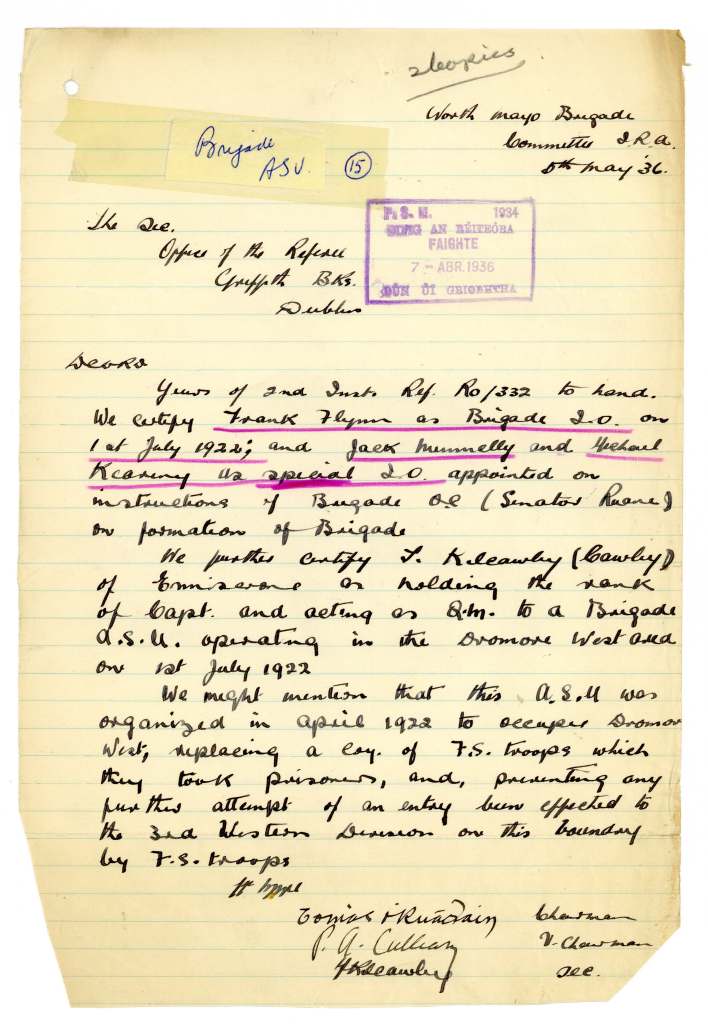
Resulting membership listings and figures while of great assistance to anyone with an interest in the period must therefore be treated with a degree of caution and cannot be taken as definitive. As already stated these records were not created contemporaneously but at a distance of over a decade and more. Many IRA officers and men had either migrated to other parts of the country or emigrated entirely. Others had died in the intervening years. It is more than possible that some former IRA members were forgotten about and left off these lists. While many IRA veterans, proud of their service and status, and only too aware of the hardships and deprivations they had suffered for the cause, would not tolerate false claims to membership or service, the boosting of membership figures to achieve a higher rate of service pension may also have been a temptation for some.
Whatever the case, evidence on the files regarding the possible submission of deliberately false or inaccurate listings, is extremely limited. The most noteworthy case, and one too complicated to go into in full detail here, can be found in files relating to 6 Battalion, 1 Kerry Brigade, IRA and in particular to Duagh and Tarbert companies (RO94A). The accusations in relation to Duagh Company was that membership figures for the company had been inflated and that a number of Service (1917-1921) Medal applicants whose claimed service had been verified by former officers from the area, had in fact not been members at all.
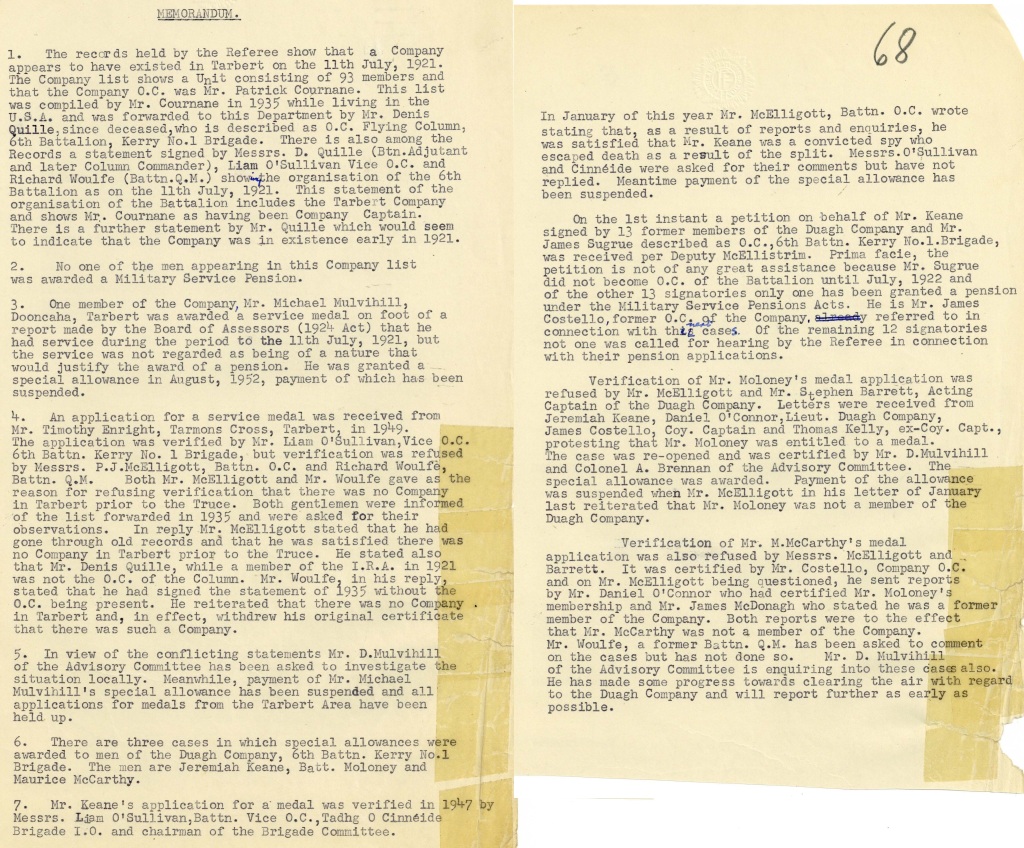
The accusations in relation to Tarbert Company were more serious again as its very existence as an IRA company was challenged. On the one hand the existence of Tarbert Company along with the position of Patrick Cournane as its commanding officer on 11 July 1921 was certified by former officers of 6 Battalion when submitting records for the Battalion. Furthermore Patrick Cournane submitted a membership listing of 93 members for the Company in 1935. On the other hand in 1952, as part of the verification process for Service (1917-1921) Medal applicants claiming membership of Tarbert Company, former 6 Battalion officers Richard Woulfe and PJ McElligott both claimed that not only was there no company in existence in Tarbert on 11 July 1921, but that the population there had been hostile to the IRA at that time. To complicate matters further Woulfe was one of the former officers who had certified Tarbert Company’s existence in the 1930s.
All of this mattered as, since the Army Pensions Act of 1946, those in receipt of Service (1917-1921) Medals could apply for a special allowance. So money was also at stake here. Eventually following claim and counterclaim from other former IRA members in the area, the Referee and Advisory Committee were forced to hold a special hearing in Listowel in July 1953 taking evidence from a number of former IRA officers and men from the area to adjudicate on medal claims from the area, to try to establish the truth regarding Tarbert Company and the claims of some of those claiming membership of Duagh company. An attempt was also made to compile new accurate membership listings for the companies, but this appears to have only added to the confusion. From the material on file it would appear that the existence of a Company in Tarbert on 11 July 1921 was accepted, but the accuracy and usefulness of the listings for the two companies was seriously questioned and many of the medal applications mentioned on file from the areas concerned were rejected.

A further complicating factor in the process of the submission and verification of records to be submitted to the Referee and his officials was the ongoing bitterness between those former War of Independence IRA comrades who had fought on opposite sides in the Civil War. As we know many of these enmities died slowly, if at all. The evidence of many War of Independence era IRA officers who had fought on the pro-Treaty side was needed to vouch for the War of Independence era claims of many who became enemies during the Civil War. While some could accept the involvement of these men in the service pension process, unsurprisingly others wanted nothing to do with them.
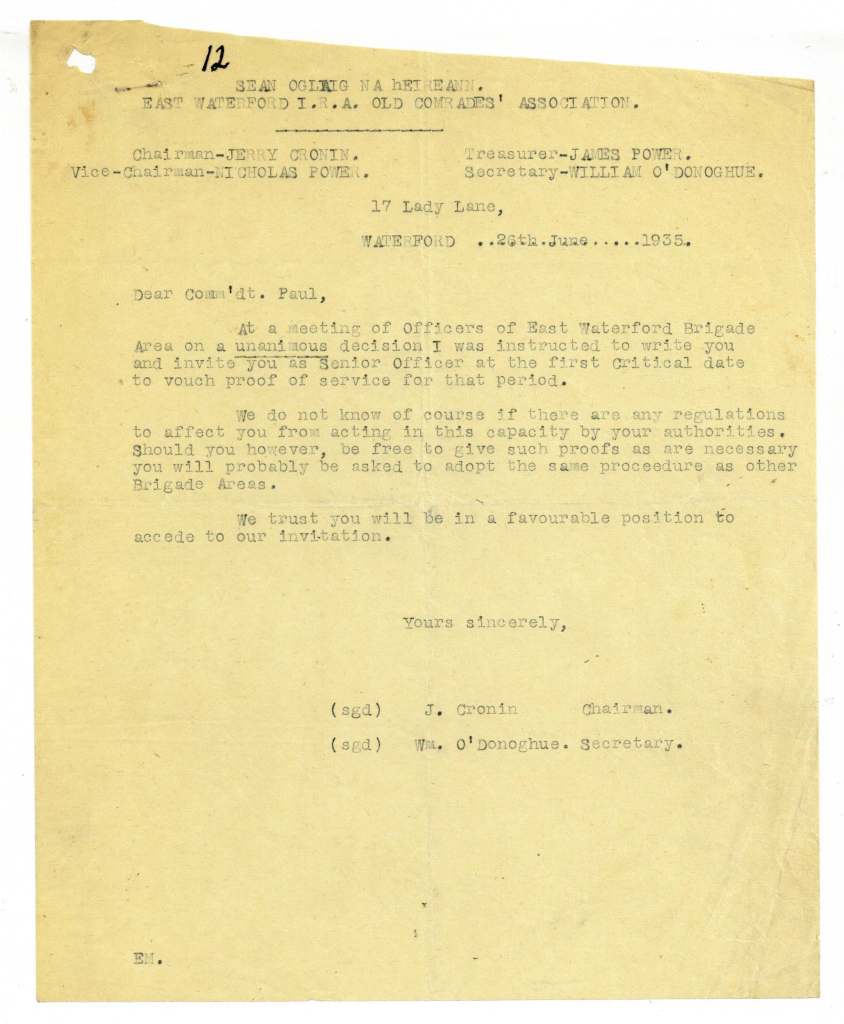
The files relating to the Waterford brigades give us one example of this conflict. On the one had in June 1935 members of East Waterford IRA Old Comrades Association wrote to the then still serving Defence Forces officer Patrick Paul to vouch for service for the first critical date – 11 July 1921. Patrick Paul was the Brigade Officer Commanding of 1 Waterford Brigade on 11 July 1921. He had taken the pro-Treaty side, served with the National Army during the Civil War, and fought against and arrested former comrades during that conflict. On the same file is evidence of the bitterness many still felt towards him. In January 1936 former anti-Treaty IRA officer Michael O’Sullivan wrote directly to the Minister for Defence in an attempt to have Paul excluded from the process. While reluctantly agreeing that Patrick Paul “…might be consulted…” when a pension applicant gave his name as a reference he stated that “…I and a considerable number here will never recognise him as a spokesman”.
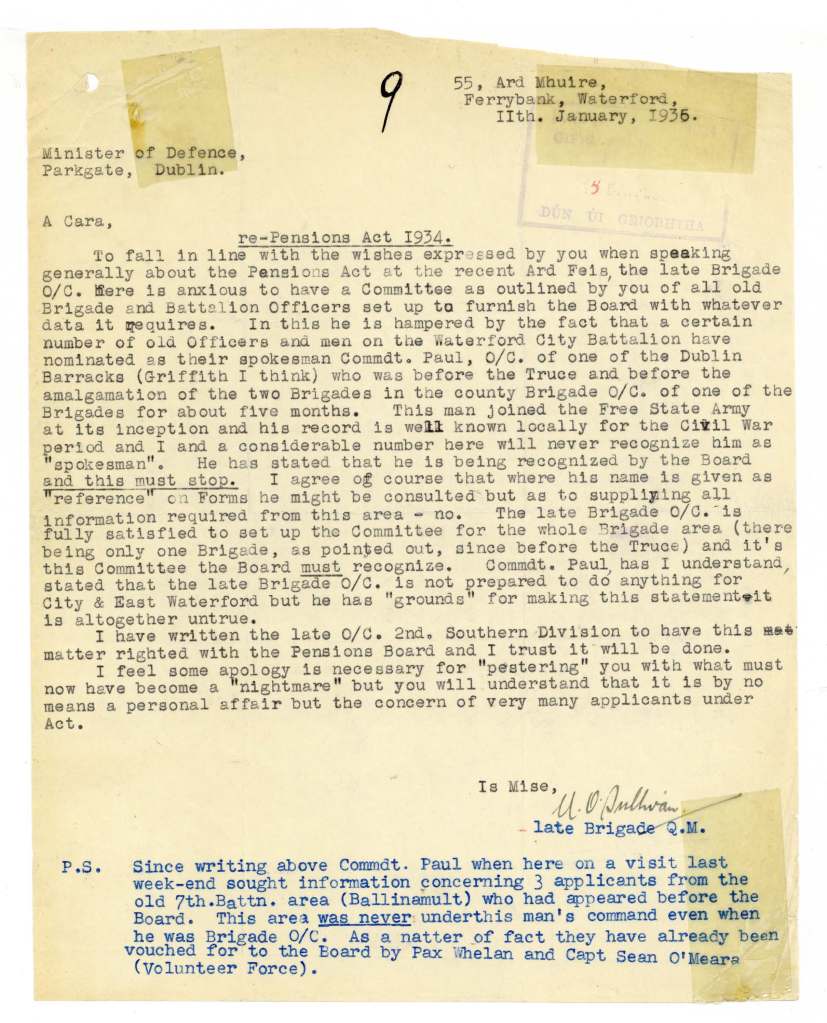
O’Sullivan was overestimating the influence which Paul would have been able to wield. While, given the size of the task facing them in adjudicating on thousands of pension applications, the Referee and his officials were happy to receive information and assistance from any who would give it, as we shall see shortly the files also show that they were also wary of the possible exclusion of any source of essential evidence. Thus they accepted and worked with membership listings supplied by Patrick Paul while also working closely with a Brigade Committee largely comprised of those who had fought against Paul in the Civil War.
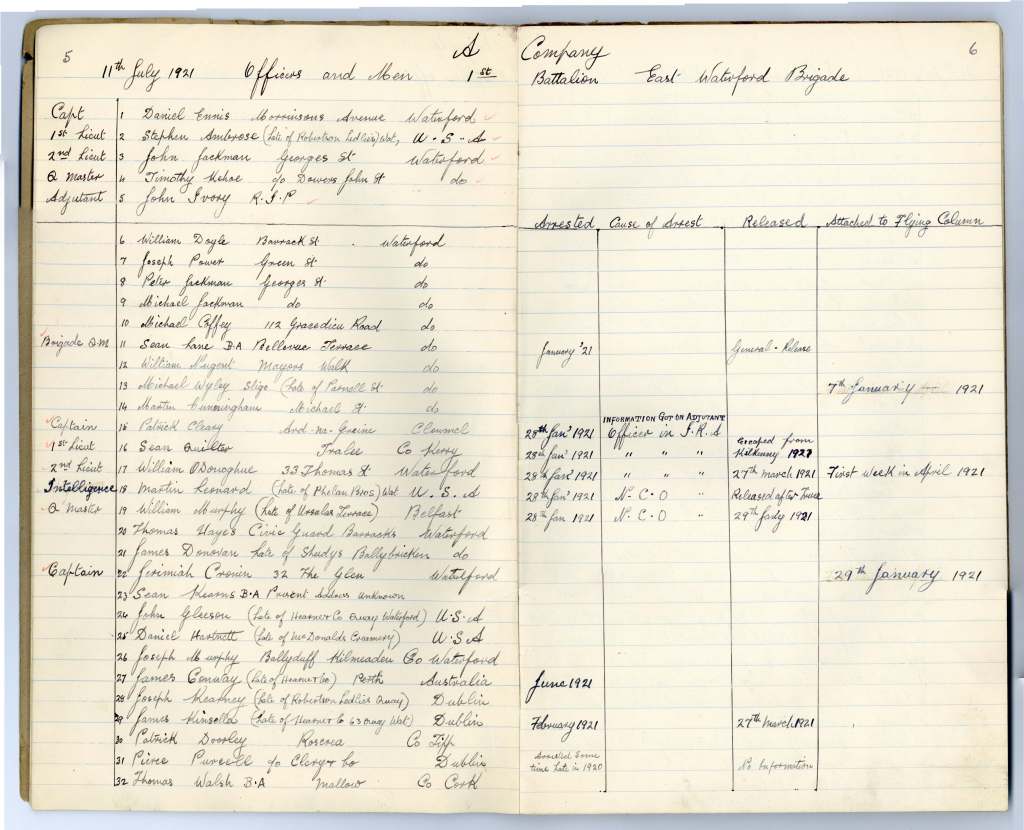
The Referee and his officials faced a possibly more difficult and complicated situation in Sligo where the files illustrate conflict not between Civil War enemies but Civil War comrades. From the material on file Sligo appears to have been rife with personality clashes and conflicting claims regarding service in the area. They seem to have centred on, but not been confined to Charles Gildea – former Divisional Quartermaster, 3 Western Division, IRA during the Civil War – and Frank Carty – a Fianna Fáil TD and former Commanding Officer of Sligo and South Sligo brigades.
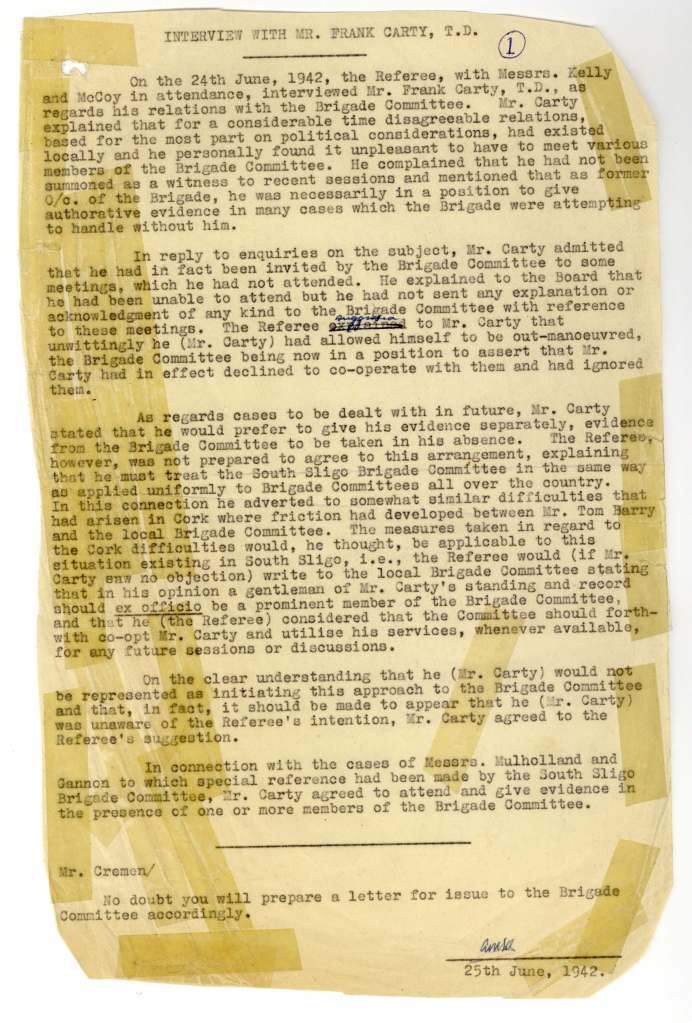
The conflict led to the dissolution of the original Brigade Committee for the area and the formation of a new one. Charles Gildea also made accusations against John Patrick Brennan – former Adjutant of South Sligo Brigade and Frank O’Beirne – former Adjutant, 3 Western Division, IRA – of making false claims to service. The situation culminated with the Referee eventually having to insist on Carty’s involvement in the working of the Brigade Committee on the grounds of Carty’s seniority and knowledge. Carty had previously removed himself from the process due to the ongoing conflict.
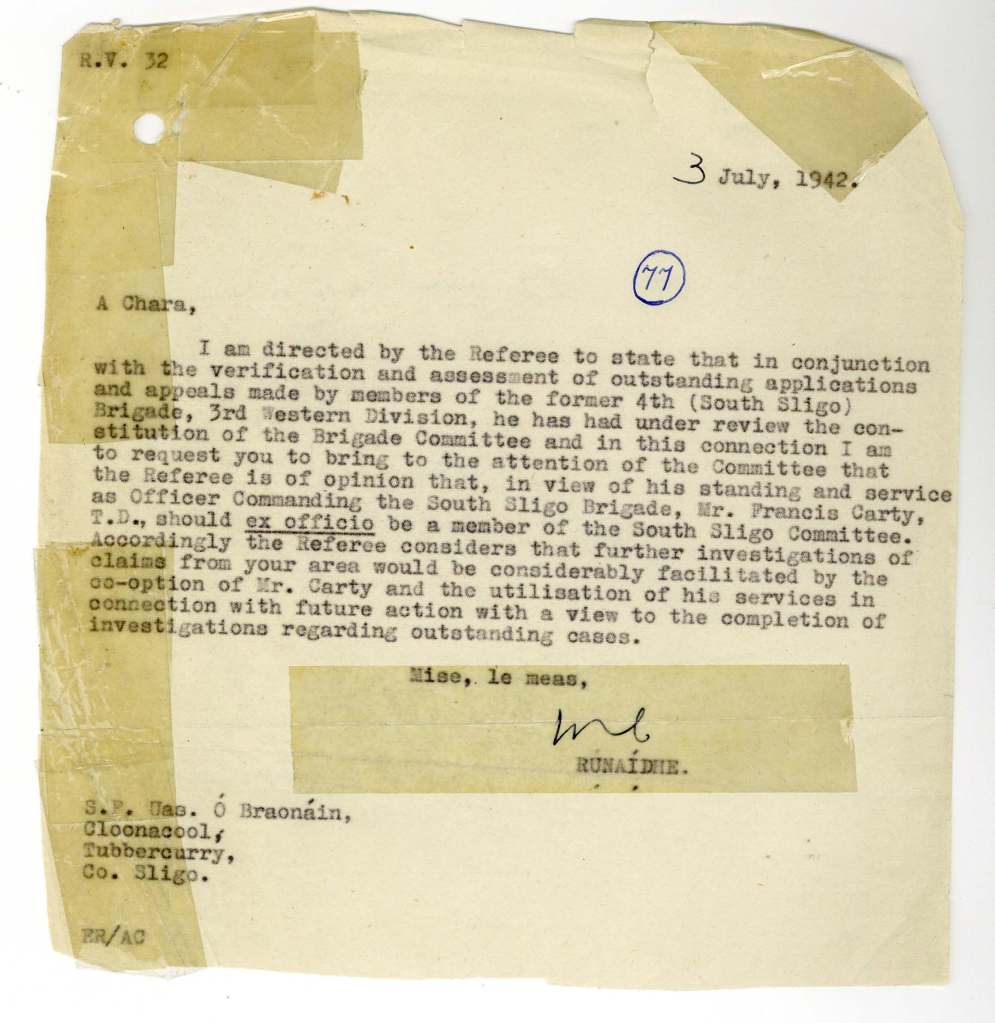
97 of the nominal roll files contain maps and there is evidence on the files that there even more maps in the files which have either been misplaced over the years or returned to whoever submitted them in the first place. The presence of maps is not surprising as the Referee actually requested that maps be submitted to illustrate the geographical areas covered by individual IRA units. What is interesting is both the maps themselves and what they tell us about the availability or such resources at that time. Today we are used to maps being freely and readily available. This was not the case in the 1930s when maps had to be printed and were expensive and hard to come by. As a result, although there are some printed maps in the collection, the vast majority are hand drawn sketch maps of varying degrees of quality.

The files also occasionally contain transcripts of discussions held between the Referee and his officials and former IRA officer regarding the history of the brigades or component units, the processing of military service pension applications and the workings of the brigade committees. These give an insight both into the history and activities of the IRA in particular areas and the relationship between the Referee and his officials, the Brigade Committees and service pension applicants.
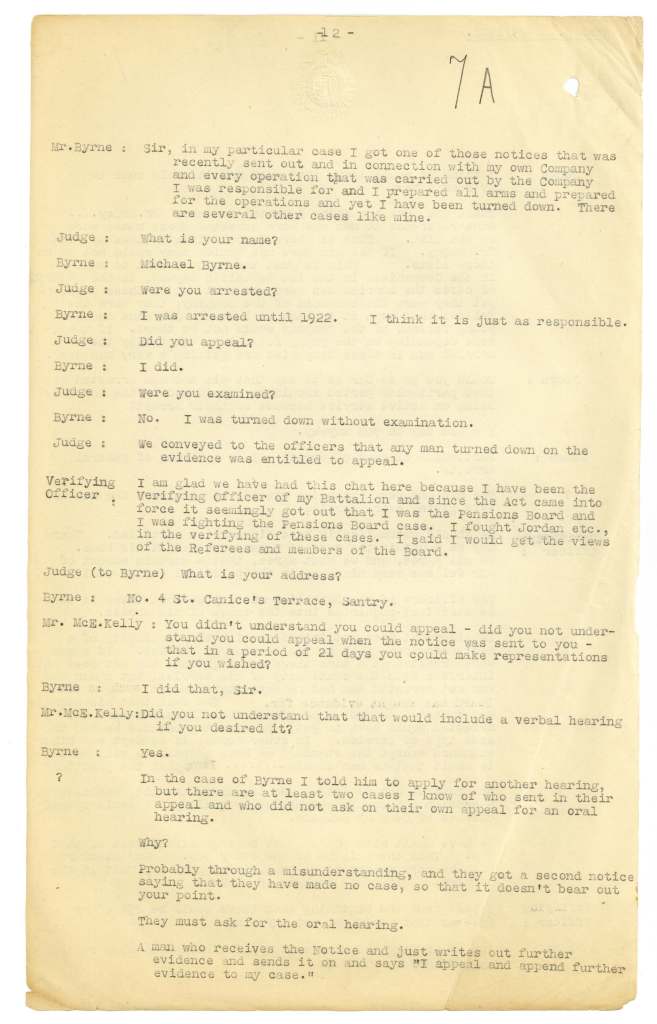

While the primary content and focus of the IRA nominal roll files are the details of membership that they contain, the associated material is also of great value. The insight they provide into areas such as the workings and administration of the military service pensions, the relationships between the Referee and his officials and the members of the brigade committees, the internal dynamics of some of the brigade committees, and the relations of those former IRA members who ended up on opposite sides in the Civil War, is also of great value and worthy of study.